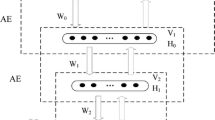Abstract
The nodes number of the hidden layer in a deep learning network is quite difficult to determine with traditional methods. To solve this problem, an improved Kullback-Leibler divergence sparse autoencoder (KL-SAE) is proposed in this paper, which can be applied to battle damage assessment (BDA). This method can select automatically the hidden layer feature which contributes most to data reconstruction, and abandon the hidden layer feature which contributes least. Therefore, the structure of the network can be modified. In addition, the method can select automatically hidden layer feature without loss of the network prediction accuracy and increase the computation speed. Experiments on University of California-Irvine (UCI) data sets and BDA for battle damage data demonstrate that the method outperforms other reference data-driven methods. The following results can be found from this paper. First, the improved KL-SAE regression network can guarantee the prediction accuracy and increase the speed of training networks and prediction. Second, the proposed network can select automatically hidden layer effective feature and modify the structure of the network by optimizing the nodes number of the hidden layer.
Similar content being viewed by others
References
Cao, S.C., Zhang, F., 2014. Review of battle damage assessment. Mil. Econ. Res., (8):53–56 (in Chinese).
Chen, X., Li, L., Liu, D., 2011. Battle damage level prediction on fuzzy theory and Bayesian method. IEEE Conf. on Robotics, Automation and Mechatronics, p.295–298. https://doi.org/10.1109/RAMECH.2011.6070499
Ding, Y., Li, N., Zhao, Y., et al., 2016. Image quality assessment method based on nonlinear feature extraction in kernel space. Front. Inform. Technol. Electron. Eng., 17(10):1008–1017. https://doi.org/10.1631/FITEE.1500439
Hastie, T., Tibshirani, R., Friedman, J., 2009. The Elements of Statistical Learning (2nd Ed.). Springer, New York, USA. https://doi.org/10.1007/978-0-387-84858-7
Hosmer, D.W., Lemeshow, S., 2005. Applied Logistic Regression (2nd Ed.). John Wiley & Sons, New York, USA. https://doi.org/10.1002/0471722146
Hubel, D.H., Wiesel, T.N., 1962. Receptive fields, binocular interaction and functional architecture in the cat’s visual cortex. J. Physiol., 160(1):106–154.
Jensen, F.V., Nielsen, T.D., 2007. Bayesian Networks and Decision Graphs. Springer, New York, USA. https://doi.org/10.1007/978-0-387-68282-2
Jiang, N., Rong, W.G., Peng, B.L., et al., 2015. An empirical analysis of different sparse penalties for autoencoder in unsupervised feature learning. Int. Joint Conf. on Neural Networks, p.1–8. https://doi.org/10.1109/IJCNN.2015.7280568
Li, C.H., Huang, J., 2014. The application of Bayesian network in battle damage assessment. IEEE Int. Conf. on Software Engineering and Service Science, p.529–532. https://doi.org/10.1109/ICSESS.2014.6933622
Ma, X.M., Ding, P., Yan, W.D., 2016. Warship-damage assessment based on Bayesian networks. Ordnance Ind. Autom., 35(6):72–75 (in Chinese). https://doi.org/10.7690/bgzdh.2016.06.017
Ma, Z.J., Shi, Q., Li, B., 2007. Battle damage assessment based on Bayesian network. 8th ACIS Int. Conf. on Software Engineering, Artificial Intelligence, Networking, and Parallel/Distributed Computing, p.388–391. https://doi.org/10.1109/SNPD.2007.421
Qin, F.W., Li, L.Y., Gao, S.M., et al., 2014. A deep learning approach to the classification of 3D CAD models. J. Zhejiang Univ.-Sci. C (Comput. & Electron.), 15(2):91–106. https://doi.org/10.1631/jzus.C1300185
Rifai, S., Vincent, P., Muller, X., et al., 2011. Contractive auto-encoders: explicit invariance during feature extraction. 28th Int. Conf. on Machine Learning, p.833–840.
Seber, G.A.F., Lee, A.J., 2012. Linear Regression Analysis (2nd Ed.). John Wiley & Sons, New York, USA. https://doi.org/10.1002/9780471722199
Song, G.H., Jin, X.G., Chen, G.L., et al., 2016. Two-level hierarchical feature learning for image classification. Front. Inform. Technol. Electron. Eng., 17(9):897–906. https://doi.org/10.1631/FITEE.1500346
Sun, G.L., Li, J., 2016. Battle damage assessment based on attribute weighted Bayesian classification. Ship Electron. Eng., 36(1):29–32 (in Chinese). https://doi.org/10.3969/j.issn.1672-9730.2016.01.009
Vens, C., Struyf, J., Schietgat, L., et al., 2008. Decision trees for hierarchical multi-label classification. Mach. Learn., 73:185–214. https://doi.org/10.1007/s10994-008-5077-3
Vincent, P., Larochelle, H., Lajoie, I., et al., 2010. Stacked denoising autoencoders: learning useful representations in a deep network with a local denoising criterion. J. Mach. Learn. Res., 11(12):3371–3408.
Wen, M.F., Hu, C., Liu, W.R., 2016. Heterogeneous multimodal object recognition method based on deep learning. J. Cent. South Univ. (Sci. Technol.), 47(5):1580–1586 (in Chinese). https://doi.org/10.11817/j.issn.1672-7207.2016.05.018
Yong, L.Y., 2004. Modeling in Battle Damage Based on Multi-agent. MS Thesis, Harbin University of Science and Technology, Harbin, China (in Chinese).
Zhang, C., Shi, Q., Liu, T.L., et al., 2012. Study on battle damage level prediction using hybrid-learning algorithm. 4th Int. Conf. on Computational and Information Sciences, p.65–68. https://doi.org/10.1109/ICCIS.2012.298
Zhao, Z.Y., Li, Y.X., Yu, F., et al., 2015. Improved deep learning algorithm based on extreme learning machine. Comput. Eng. Des., 36(4):1022–1026 (in Chinese). https://doi.org/10.16208/j.issn1000-7024.2015.04.036
Author information
Authors and Affiliations
Corresponding author
Additional information
Project supported by the National Basic Research Program (973) of China (No. 61331903) and the National Natural Science Foundation of China (Nos. 61175008 and 61673265)
Rights and permissions
About this article
Cite this article
Qi, Zf., Liu, Qq., Wang, J. et al. Battle damage assessment based on an improved Kullback-Leibler divergence sparse autoencoder. Frontiers Inf Technol Electronic Eng 18, 1991–2000 (2017). https://doi.org/10.1631/FITEE.1601395
Received:
Accepted:
Published:
Issue Date:
DOI: https://doi.org/10.1631/FITEE.1601395
Key words
- Battle damage assessment
- Improved Kullback-Leibler divergence sparse autoencoder
- Structural optimization
- Feature selection




